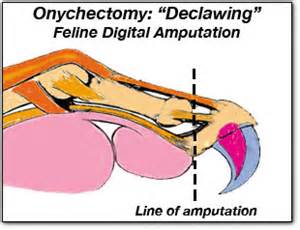

Custom Search
|

Onychectomy is the act of surgically removing the nails, or claws, most often of a household cat, though occasionally of other animals such as circus lions or dancing bears. This process involves amputating the ends of the digits under anaesthesia, and is popularly known as declawing.
The incidence of declawing varies widely from country to country. In the United States and Canada, it is widespread, although precise figures are hard to come by and there is considerable variation within North America. It is a controversial subject, and often causes heated debate between those who believe it is cruel and that owners who declaw are putting the health of their furniture before that of their cat, and those who argue that declawing is better option in some cases than sending a cat to a shelter where it may be euthanised. A few places, such as West Hollywood, have outlawed the practice entirely, but this is not a common occurrence.
In the United Kingdom, declawing is extremely uncommon, to the extent that most people have never seen a declawed cat. The procedure is considered cruel by almost all British veterinarians, who refuse to perform it except for medical reasons. The Mutilations report found in an annex of the Royal College of Veterinary Surgeons's Guide to Professional Conduct states:
In many European countries, it is forbidden under the terms of the European Convention for the Protection of Pet Animals, unless there is a medical indication for the procedure, or a veterinarian considers it beneficial to the animal. Some European countries go further, such as Germany and Switzerland, where declawing cats is always illegal under their laws against cruelty to animals.
In Australia, legislation concerning animal welfare is enacted at the state level and is highly inconsistent. There are ongoing efforts to develop a National Animal Welfare Act; in its current state, the bill would prohibit the declawing of cats except for medical reasons. However, some pro-wildlife campaigners advocate declawing (and possibly defanging) to protect native wildlife from pet cats.
One popular, relatively inexpensive alternative to declawing is the application of vinyl nail caps (marketed in the US as Soft Paws® or Soft Claws®) that are affixed to the claws with nontoxic glue, requiring periodic replacement when the cat sheds its claw sheaths (usually every four to six weeks).